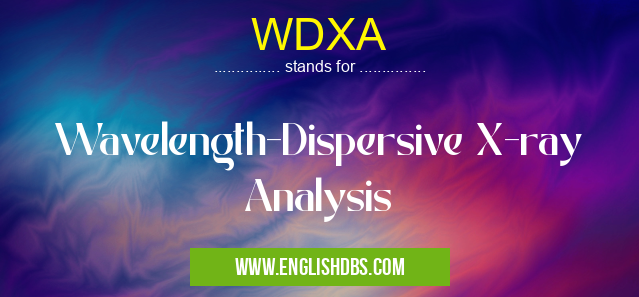What does WDXA mean in ELECTRONICS
Wavelength-dispersive X-ray analysis, otherwise known as WDXA, is a emission scanning technique used to analyse the chemical elements present in a sample. It is used mainly in scientific research and materials analysis. It works by passing an X-ray beam through a sample, which then spreads out according to its wavelength due to being refracted from crystalline structures. The light that results from this process can then be analysed for various characteristics such as intensity and composition. This provides useful data about the elemental composition of the sample being studied.

WDXA meaning in Electronics in Academic & Science
WDXA mostly used in an acronym Electronics in Category Academic & Science that means Wavelength-Dispersive X-ray Analysis
Shorthand: WDXA,
Full Form: Wavelength-Dispersive X-ray Analysis
For more information of "Wavelength-Dispersive X-ray Analysis", see the section below.
What is Wavelength-Dispersive X-Ray Analysis (WDXA)?
Wavelength-dispersive X-ray analysis is a scanning technique which makes use of an X-ray beam that passes through a sample and gets refracted by crystalline structures within the sample. This results in wavelengths spreading out according to their individual characteristics and these variations are then picked up by detectors, providing a measure of intensity for each wavelength or frequency. This intensity variation is then analysed to provide information about the elemental composition of the sample, enabling scientists to gain insight into its properties and structure. In short, WDXA is a branch of analytical science which studies samples using X-rays with varied wavelengths in order to determine what elements they contain and how these elements interact with one another. As well as offering insights into structural properties, it also helps scientists identify any impurities present in the sample material as well as determining overall purity levels.
Uses of Wavelength Dispersive X Ray Analysis
WDXA has numerous uses within scientific research and material analysis. One common application is within metallurgical testing, where it can be used to measure trace elements in metal samples like alloy steel and superalloys at extremely low concentrations - down to parts per million (ppm). In this field, it offers invaluable insight into metal properties such as tensile strength and wear resistance which aids researchers in producing improved alloys suitable for high performance applications like aerospace engineering or nuclear power generation systems. WDXA has also been used extensively in archaeology for decades now; helping researchers identify provenance by analysing the mineralogy of artifacts from different archaeological sites across the world. For example if multiple sources of obsidian artefacts are found at different sites WDXA could be employed to distinguish between them based on their chemical make up; allowing researchers to piece together connections between ancient cultures who may have traded goods over long distances centuries ago but left no written record behind.
Essential Questions and Answers on Wavelength-Dispersive X-ray Analysis in "SCIENCE»ELECTRONICS"
What is Wavelength-Dispersive X-ray Analysis (WDXA)?
WDXA is a form of X-ray spectrometry that uses X-rays to identify and quantify elements within a sample. It works by using a monochromatic X-ray source to excite the electrons in an element, which then emit characteristic secondary X-rays with well defined energies that can be used to identify the element.
How does WDXA differ from energy dispersive X-ray analysis?
WDXA has higher resolution and accuracy compared to energy dispersive analysis because it produces better results in terms of determining the elemental composition of the sample material. While energy dispersive analysis is faster in its data acquisition, WDXA provides more detailed information on each element in the sample.
What types of samples can be analyzed using WDXA?
A wide variety of materials such as ceramics, metal alloys, polymers, semiconductors, geological specimens, glass powders and coatings can be analyzed using WDXA.
What are some applications of WDXA?
WDXA can be used for applications such as quality control analyses for industrial production lines; failure analyses for components; trace analysis; environmental studies; mineralogy research; forensic examinations; and scientific measurements.
What are the benefits of using WDXA over other analytical techniques?
One advantage is that it provides a more sensitive detection limit than other methods such as flame atomic absorption spectroscopy or Inductively Coupled Plasma Mass Spectrometry (ICPMS). Additionally, because it has excellent spectral resolution and sensitivity CCD technology, resulting data sets can far exceed those measured with other techniques. Moreover, its non-destructive nature ensures there is no damage done to the sample material during initial testing and evaluation.
Are there any special requirements regarding sample size or composition when using this technique?
Sample size typically must be large enough to sufficiently interact with a given amount of incident x rays while also being small enough so that absorption effects become negligible in comparison with scattering processes in order to get reliable results. In terms of composition, both solids and liquids can be tested but must have sufficient stability at room temperature so that radiation damage becomes minimal during testing process.
Is there any sample preparation necessary before conducting an experiment through this method?
Yes - samples should either be pressed into pellets or finely ground prior to testing if they are solid materials while liquid samples should first undergo acid digestion before obtaining quantitative results.
Final Words:
In conclusion WDXA is an invaluable tool both for material analysis and scientific research due its ability to offer detailed insights into elemental composition without needing destructive methods such as grinding or crushing specimens down into powder form first; speeding up timescales involved greatly compared with traditional laboratory techniques such as Inductively Coupled Plasma Emission Spectroscopy (ICPES). Its applications range widely too from metallurgy studies right through archaeology investigations; proving itself an extremely versatile tool within analytical science that continues to expand its influence further every day!
